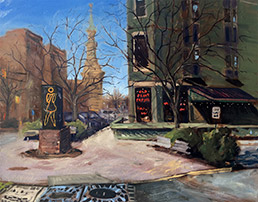Subscriber Benefit
As a subscriber you can listen to articles at work, in the car, or while you work out. Subscribe NowIt was initially supposed to just be a stress-relieving exercise. Justin Vining, a 2010 graduate of Valparaiso University Law School, was feeling the pressure of being a full-time law student, so he picked up a brush and some paint and poured his anxieties out onto a blank canvas.
But then something happened — Vining’s paintings began to sell. At first, he created seven paintings in just two weeks and sold them all to his classmates. By the end of his law school career, he had sold more than 400 works, all while clerking and taking classes.
Vining found work as a corporate headhunter after passing the bar, so he moved to Indianapolis with the intention of working and maintaining his online art business. But as he settled into life as a working professional, his art sales began to suffer, and Vining knew he had to make a choice.
Ultimately, Vining’s choice nearly seven years ago was to pursue a career as a full-time artist, a move he concedes was risky, but has proven to be wise. But Vining still maintains an active Indiana law license and all of the applicable requirements, including earning the required number of continuing legal education credits each year. Plus, Vining’s ties to the Hoosier legal community run deep, as former professors, classmates, supervisors and colleagues have his work hanging in their homes and law offices across the state.
 Vining
Vining“I create my livelihood, and I find a great amount of freedom in that,” Vining said.
Becoming a full-time painter has been a third career for Vining, who first worked as an elementary school art teacher before matriculating at Valparaiso Law. Building a legal career was supposed to be a family affair for Vining and his younger brother, Nathan. They enrolled at Valparaiso Law together and were known around the campus as a team.
But subtle signs foreshadowing Vining’s future career path were always present while he was a law student. For example, Valparaiso Law professor David Herzig recalled walking into classrooms around the law school and finding drawings created by Vining left on white boards for the whole school to enjoy. No one ever erased those drawings, Herzig said, but instead looked forward to discovering where the next one would be found.
“It’s kind of like an urban myth,” Herzig said.
Brad Koeppen, who supervised Vining when he worked as a clerk at the Valparaiso firm Douglas Koeppen & Hurley, recalled Vining being torn between the law and his art. Vining was talented in both arenas, Koeppen said, which made it difficult for him to choose between the two.
Vining’s artistic talents are well-known in Valparaiso, Koeppen said. For example, Vining once painted a mural on the side of a building in downtown Valparaiso, and he has also contributed his work to a fundraising auction for the local YMCA.
“He got a lot of followers from that display,” Koeppen said of the auction. “A lot of local people fell in love with his artwork. He has avid backers here in town that have purchased a lot of his art.”
Though the northern Indiana native values his support in Valparaiso, Indianapolis has proven to be the ideal market for Vining’s young art business. That’s because the city is big enough for him to have many clients, yet small enough for him to make a name for himself and set himself apart from the crowd, he said.
“It really is just a big small town,” Vining said.
 Justin Vining describes himself as an oil landscape artist who paints scenes from around Indianapolis, such as this depiction of Massachusetts Avenue in a piece known as “Ann Dancing.” (Photo courtesy of Justin Vining)
Justin Vining describes himself as an oil landscape artist who paints scenes from around Indianapolis, such as this depiction of Massachusetts Avenue in a piece known as “Ann Dancing.” (Photo courtesy of Justin Vining)Indianapolis has even inspired Vining’s work, which he said has evolved over the last two years. While his early paintings depicted whimsical Midwestern landscapes, Vining has transitioned to observational plein air, or open air, oil paintings that depict scenes from around Indianapolis. Whether it’s Garfield Park, Broad Ripple, Monument Circle or the Indianapolis Museum of Art, it’s not uncommon to find Vining set up with a brush and some paint near popular Indianapolis spots, recreating the world around him on his canvas.
Law firms have been among Vining’s best clients, as his friends in the legal industry are supportive of his artistic career and want to promote his work. Koeppen, for example, has multiple Vining paintings hanging in his Valparaiso office, while Herzig said the walls of Valparaiso Law School feature the work of its artistic alum. During his 3L year, Vining involved his classmates in his creative process, inviting the entire graduating class to his apartment to create a canvas that was left as a gift to the school.
It’s not just law firms that have taken an interest in Vining’s landscapes. At his annual show in March 2017, Vining sold 71 paintings on opening night alone, a feat he said could be indicative of future success. So far this year, Vining has sold roughly 150 paintings, and he’s on track to sell at least 200 works before the year ends.
Yet even with that level of success in the world of art, Vining still keeps a foot in the door of the Hoosier legal community. For example, his younger brother runs the solo firm Vining Law in Indianapolis, and occasionally the elder Vining will step in when his brother needs an extra set of hands, temporarily trading in his brush for legal briefs.
“I’ll ask him, ‘Hey, can you throw on a suit for me?’ and I think he really enjoys getting to do that occasionally,” Nathan Vining said. “And it really helps me out, because being a smaller office, having another person helps a lot.”
Vining has also shared his expertise in both the law and art with the next generation of lawyers at the Indiana University Robert H. McKinney School of Law, where he has served as a guest lecturer in the Art & Museum Law course. During his lectures, Vining discussed the intellectual property and contractual issues he faces as a full-time artist, areas of his business he said would have been more difficult for him to maneuver without his legal training.
Though becoming an artist isn’t a traditional career path for most law school graduates, Nathan Vining said his brother’s time with the law was a benefit to his artistic career because it enabled him to get perspective on his work from his peers in the legal community, both in a creative sense and from a business perspective.
Justin Vining agreed, recalling one instance in which a law school classmate suggested he use Facebook paid advertisements to promote his work. Those kinds of suggestions that came while he was still pursuing a legal career equipped Vining with the knowledge and skills that have enabled him to succeed as a creative professional, he said.
“In law school, being surrounded by more entrepreneurial, business-minded people, I think it helped change the way I think about it,” Vining said. “I think that foundation was really what sort of jump started my comparative advantage.”•
Please enable JavaScript to view this content.

